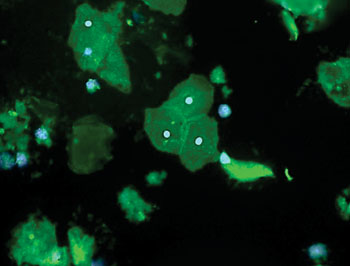Prenatal Genetic Test Is Accurate Five Weeks into Pregnancy
By LabMedica International staff writers
Posted on 16 Nov 2016
The latest developments in prenatal technology make it possible to test for genetic disorders a little more than one month into pregnancy using a non-invasive technique.Posted on 16 Nov 2016
Single-gene mutations are responsible for a large number of diseases and contribute to a sizeable fraction of pediatric hospitalizations and deaths. Current methods for prenatal diagnosis of such mutations are limited because they are invasive, except for detection of circulating fetal DNA, which is safe but can be difficult to perform accurately, and most cannot be performed early in pregnancy.

Image: Placental fetal cells isolated safely using the TRIC procedure were stained for beta- human chorionic gonadotropin (hCG) (green) a trophoblast cell marker and nuclei were labeled using DAPI dye (Photo courtesy of Sascha Drewlo, PhD).
Scientists at the Wayne State University (Detroit, MI, USA) isolated intact trophoblast cells from Papanicolaou (Pap) smears collected noninvasively at 5 to 19 weeks of gestation for next-generation sequencing of fetal DNA. Consecutive matched maternal, placental, and 20 fetal samples were profiled by multiplex-targeted DNA sequencing of 59 short tandem repeat and 94 single-nucleotide variant sites across all 24 chromosomes.
The non-invasive testing method known as Trophoblast Retrieval and Isolation from the Cervix (TRIC), offers the accuracy of more invasive tests, such as the needle-directed amniocentesis, and can also be utilized five to 10 weeks earlier than current testing modalities. The method isolates several hundred fetal cells that migrate from the placenta into the uterus using a retrieval technique akin to the common Pap smear, and can be done as early as five weeks into pregnancy. The data revealed fetal DNA fractions of 85% to 99.9%, with 100% correct fetal haplotyping. This noninvasive platform has the potential to provide comprehensive fetal genomic profiling as early as five weeks of gestation.
D. Randall Armant, PhD, the principal investigator and Professor of Obstetrics and Gynecology, said, “Because the cells we purify by TRIC are placental cells that have a critical function early in pregnancy, their protein profile has been examined to determine if it becomes different in pregnancies that have serious complications like a miscarriage, undersized fetus or preeclampsia. Since TRIC provides the cells of interest, we can probe their RNA and protein profiles using next-generation proteomics and transcriptomics approaches. The study was published on November 2, 2016, in the journal Science Translational Medicine.
Related Links:
Wayne State University




 assay.jpg)









